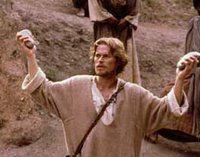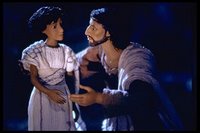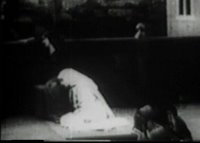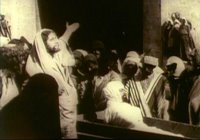Peter T Chattaway has just had his list of
Top Ten Jesus Films published by
Christianity Today. We chatted a bit about the subject a while back and I've been meaning to post my list for a while. Peter's films are:
The Life and Passion of Jesus Christ (1902-05)
The King of Kings (1927)
The Gospel According to St. Matthew (1964)
The Greatest Story Ever Told (1965)
Godspell (1973)
The Messiah (1976)
Jesus of Nazareth (1977)
Jesus (1999)
The Miracle Maker (2000)
The Passion of the Christ (2004)
Since Peter has now had his list published, and, as this is the last major post before Good Friday I thought it was probably about time I posted mine up as well. We actually agree on 6, although I'd be happy to swap 2 of those 6 for 2 on my list of honourable mentions further below. However, here are my Tope Ten Jesus films in chronological order:
From the Manger to the Cross (1912)

More of a film than
The Life and Passion of Jesus Christ, more natural and genuine than DeMille's
The King of Kings, This film, for me, stands out as the best Jesus film of the silent era. Controversial in it's day, for its very existence, (not to mention its ommission of the resurrection), Sidney Olcott's film has a quiet dignity about it, which is best captured by turning off the overbearing sountrack which was added later. The film was re-issued with a resurrection scene in 1916 as
Jesus of Nazareth, and under that title again in 1932 with sound.
 Golgotha (1935)
Golgotha (1935)Golgotha was the first Jesus talkie, and set a high standard for those that were to follow> originally released as
Ecce Homo. Julien Duvivier's use of the camera was way ahead of his time and he manages to capture the miraculous events in Jesus's last week as if they were the most natural thing in the world.
My reviewKing of Kings (1961)
The first Hollywood film about Jesus since the end of the silent era 34 years earlier.
King of Kings remains enjoyable even though behind the scenes power stuggles destroyed the films promise. The Sermon on the Mount scene is still wonderful though, even if elsewhere Jesus is squeezed out of the film by the zealots.
My reviewIl Vangelo Secondo Matteo (1964 - The Gospel According to St. Matthew)
Widely considered the masterpiece of the genre, at least among film critics, Pasolini's neo-realist style gave us a Jesus of the people, who delivers his pithy sayings with revolutionary urgency. The camera work draws the viewer into the story more, whilst the use of ordinary people cuts through the gloss of so many Jesus films both before and afterwards.
Il Messia (1975 - The Messiah)
The Godfather of neo-realism was Roberto Rossellini who ended his career with this film. Like Pasolini's film, Rossellini depicts a peasant Jesus, who continues his carpentry even as he teaches, and whose followers pass on his message at the same time he does. Of all the versions of Jesus in film this one perhaps focusses the most on his teaching. The film is also unusual for it's opening scenes from the time of Samuel.
 Jesus of Nazareth (1977)
Jesus of Nazareth (1977)One of my least favourite films in this list, and yet where would the genre be without it? In many people's eyes the definitive film Jesus, and a favourite amongst the faithful, Zefferelli does so much very well. Sadly, his leading character is dreary, and the film drags on without a charismatic compelling lead. That said the other performaces are wonderful and the period detail is impressive.
Last Temptation of Christ (1988)
A mixture of the good, the bad, and the dull. In parts Scorsese's film soars breathing new life into the character of Jesus and challenging the viewer about their cosy pre-conceptions. In other places though the film, is just bizarre and has offended many, whilst still other places seem to drag. For those looking for fresh insights and who like to judge films on their merits there is plenty to be mined here. For those who find whole films are spoiled by particular sections stay away, particularly if you are easily offended.
My reviewJesus (1999) Jesus
Jesus explores similar territory to
Last Temptation, but in a safer more palatable form. Sisto's performance has many strengths, but it slightly spoilt by a few too many scenes of of him goofing around. That said the early scenes are particularly strong. Much of it is speculation, but certainly such that is within reason. It's also one of the few films to clarify that that it was the Romans, not the Jewish leaders that were in charge in Jerusalem in Jesus's time.
The Miracle Maker (1999)
The claymation version of Jesus's life is one of the genre's highs. Whilst clearly less arty than Pasolini's film, it is theologically, and historically strong, and surprisingly moving for a stop motion film. Ralph Fiennes does an excellent job as the voice of Jesus, and Murray Watts's scripts is excellent but the most credit must go to the team of animators who produced a wonderfully realistic and creative film.
My reviewPassion of the Christ (2004)

Whilst there are several troubling aspects of this film Mel Gibson did plenty of excellent work with this as well. The film looked incredible, and whilst it starved us of insights into Jesus's earlier life, the few scraps we were allowed certainly aroused our appetites for more. And as filmic meditations on the stations of the cross go, I doubt it will be surpassed.
Honourable mentionsThere are a few films which I had to exclude, for various reasons, but which really deserve a mention.
Son of Man (1969) Son of Man
Son of Man isn't really a film, it's the filmed version of a Dennis Potter play. Nevertheless it remains one of the strongest visual portrayals of Jesus to date. Colin Blakely portrays a Jesus with fire in his belly, who speaks in the language of normal people, but in a manner that makes his collision with the authorities inevitable. The Sermon on the Mount scene again is amazing, and deserves repeated viewings.
Life of Brian (1979)
This is excluded form the list becuase it isn't actually a film about Jesus (although he makes a brief cameo at the start). Instead it's about the folibles of religion, and of humanity in general.
Life of Brian does what all good films do - be excellent at something. In this film's case its comedy is hilarious hwilst remaining thoughtful. As a result it has gained a dedicated following, and appears time after time in those "best of" programmes.
Jesus of Montreal (1989)
Jesus of Montreal is another satire, only this time the target is modern day Quebec. The film follows five actors as they put on a controversial passion play which and finds the life of the groups leader mirroring that of Jesus whom he plays in the film. Perhaps the strangest scenes at a first viewing, is actually one of the best - where Jesus wanders through the subway proclaiming God's judgement in the style of Mark 13.
 Book of Life (1999)
Book of Life (1999)Hal Hartley's film stars Martin Donovan as Jesus returning to earth on the eve of the new Millennium, and finding that his love for humanity conflicts with his mission. Another sharply observed satire which explores form as well as content.
Labels: Book of Life, From the Manger to the Cross, Golgotha, Gospel According to St. Matthew, Il Messia, Il Vangelo Secondo Matteo, Jesus (1999), Jesus of Montreal, Jesus of Nazareth, King of Kings, Last Temptation of Christ, Life of Brian, Lists, Miracle Maker, Passion of the Christ, Silent Bible Films, Son of Man (1969)
 Another fact from "The Guinness Book of Film Facts and Feats". The 1912 film From the Manger to the Cross is often cited as (one of) the first feature film(s) ever made. Here (p.17) it lists the earliest feature films made in the US, and From the Manger ranks fourth, with Oliver Twist being released in 7 months earlier in June 1912.
Another fact from "The Guinness Book of Film Facts and Feats". The 1912 film From the Manger to the Cross is often cited as (one of) the first feature film(s) ever made. Here (p.17) it lists the earliest feature films made in the US, and From the Manger ranks fourth, with Oliver Twist being released in 7 months earlier in June 1912. 





































